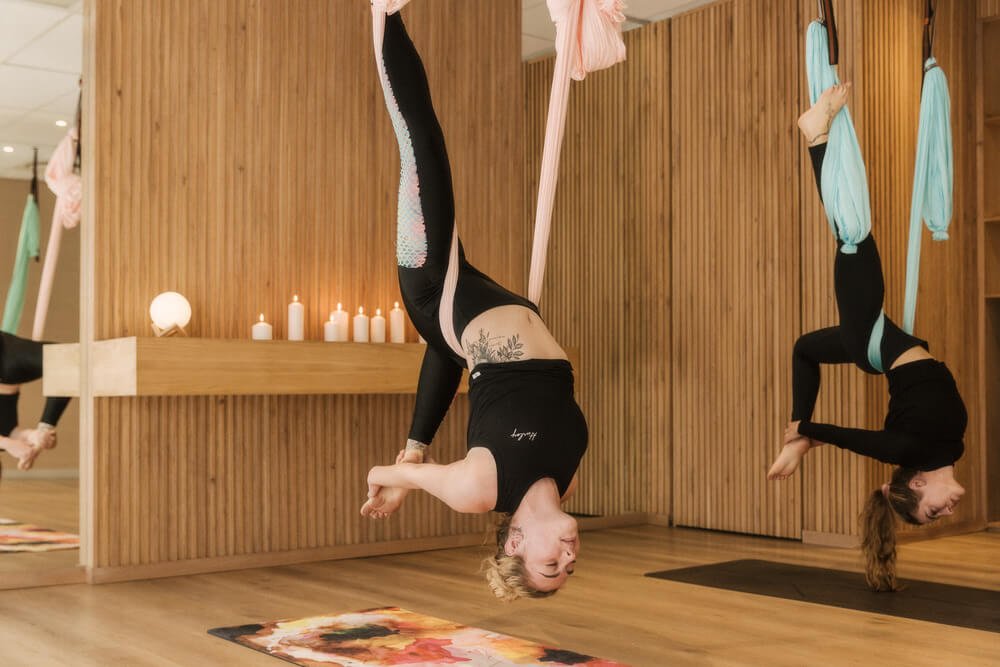The benefits of aerial yoga for anxiety and depression help with both physical and mental health. This is why in recent years, yoga has become a common ‘treatment’ for people who battle anxiety and depression. This is one of the reasons both Sabrina and I do yoga. It helps with body, mind, and spirit, providing a holistic way of being in your body.
Anxiety and depression often make us want to leave our bodies. Our physical form, combined with our mind, becomes the enemy, and we often become desperate to escape. Yoga brings you into your body in a way that makes you love being in it. It fosters self-love, better awareness, and a way to work with the mind rather than against it.
Aerial yoga takes this to a whole new level.
Summary of Benefits of Aerial Yoga for Depression and Anxiety
Depression and Anxiety take a toll on both the body and the mind. Yoga is an excellent way to release the tension and intense energy stored up in the body. Aerial yoga poses boast all the benefits of traditional yoga asanas and offers even more.
Physical Benefits
- Expose the body to a new and challenging environment which builds courage and confidence
- Decreased inflammation
- Builds body awareness
- Improves strength, stamina, and flexibility
- Alleviates muscle tension
- Strengthens core and improves mobility in joints
- Yoga hammock assists with alignment and allows you to hold poses for longer
- Enhances proprioception
- Improves spinal health and posture
- Reduces neck and back pain
- Works into areas you don’t usually work
- Assists respiratory, cardiovascular, digestive, and lymphatic systems
To explore more about this, check out of post on the physical benefits of aerial yoga.
Mental and Emotional Benefits
- Improves focus, concentration and mental function
- Relieves anxiety and depression
- Improves mood
- Activates the parasympathetic nervous system
- Improves sleep
- Lifts mood by releasing serotonin, dopamine and endorphins
- Hammock pressure releases oxytocin creating a sense of safety and security

Aerial Yoga for Anxiety
Aerial yoga requires 100% focus since it is an extreme practice. Because of this, it brings your mind into the present. There’s no space for worries about the future.
By practicing aerial yoga and mindfulness on a regular basis, new pathways can be created in the brain. This helps both your mental and physical health.
The Digestive System and Aerial Yoga
The gut and the brain are connected, and they influence each other heavily. The gut is often referred to as our second brain and is extremely sensitive to our emotions. If you’ve got anxiety, then you’ll know exactly how connected these two are. Aerial yoga is great for alleviating constipation and indigestion.
Adrenaline and Cortisol
Anxious people are extremely familiar with the sympathetic nervous system. We’re no strangers to adrenaline and cortisol. In fact, we’re pretty familiar with them. With anxiety disorders like GAD or Social Anxiety Disorder, these hormones are present in the body more often than not.
Aerial yoga is an extreme version of yoga. It challenges you, makes you face your fears, and gets your adrenaline pumping (in a healthy way). With the help of a yoga hammock, you can take your body to unfamiliar places.
Aerial yoga can help us re-regulate our nervous system. Even though we work in our sympathetic nervous system during practice, we also settle into our parasympathetic nervous system during savasana. Here we activate our rest and digest response, bringing calming energy into our body.
Aerial Yoga for Depression
When depression hits, it can be hard to leave the comfort and security of your own bed. But an aerial yoga class allows you to move through the muddy mind space. Getting on the mat or into your aerial yoga hammock is the hardest part when you’re battling depression, but you won’t regret it.
If you’re low on energy and can’t fathom expending the little energy that you have, practices like restorative aerial yoga and traditional restorative yoga can be great. The restorative yoga style requires very little effort and movement and comes with plenty of benefits. It’s all about restoring and healing.
Is Aerial Yoga Good for Depression?
When you’re depressed or anxious, your body needs happy hormones more than ever. These can help to lift your mood, giving you the energy and power you need to fight through the darkness. Happy chemicals or neurotransmitters are brain chemicals that are vital to mood regulation.
Aerial yoga triggers the release of these hormones, giving your body and mind what they need to heal, build resilience and strengthen.
The Power of Inversions
With anxiety comes a whole bunch of other unpleasant ‘side effects’. These present as muscle pain, headaches, achy jaws, tight and stiff muscles, and a whole lot of tension. Aerial Yoga allows you to unwind this tension, releasing pressure and realigning your body.
Aerial Yoga inversions help you to create space in your spine, give your heart a break and literally flip your world upside down.

Inversions are magic if you suffer from lower back pain. It can even assist with chronic pain.
Besides this, being upside down releases neurotransmitters. These can help reduce depression, anxiety, and intense emotions and leave you feeling lighter, calmer, and a hell of a lot happier.
Inversions also help us detoxify our lymphatic system. This helps keep our immune system strong, which is essential. If you’re a part of the anxiety and depression club, you’ll know how these two wreak havoc on your physical health.
Aerial yoga flushes out our lymphatic system, giving our bodies the space to revitalize and get rid of toxins. Inversions also help to cleanse our body, filling it with fresh blood, nutrients, and oxygen.

More on the Benefits of Aerial Yoga
Despite being extreme, aerial yoga is still gentle and is designed to work with you rather than against you. It’s meant to be challenging but in a way that makes you feel comfortable. If you’d like any more information on Aerial yoga and it’s benefits, please reach out to us or come join one of our aerial yoga classes.




